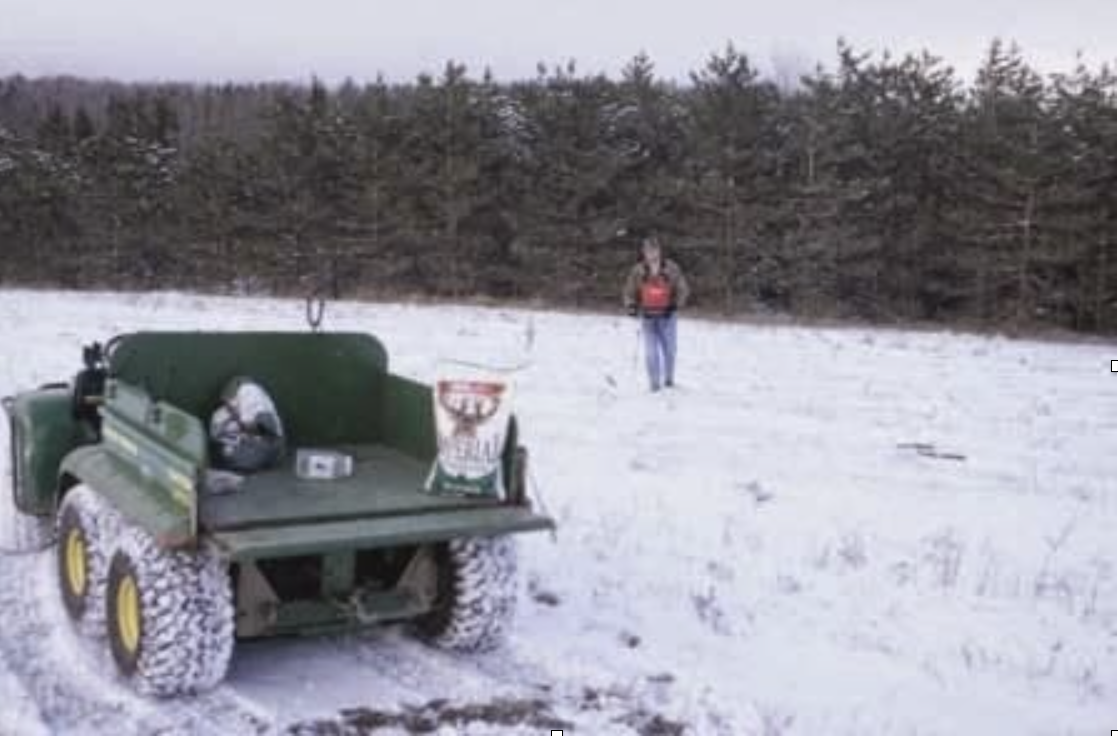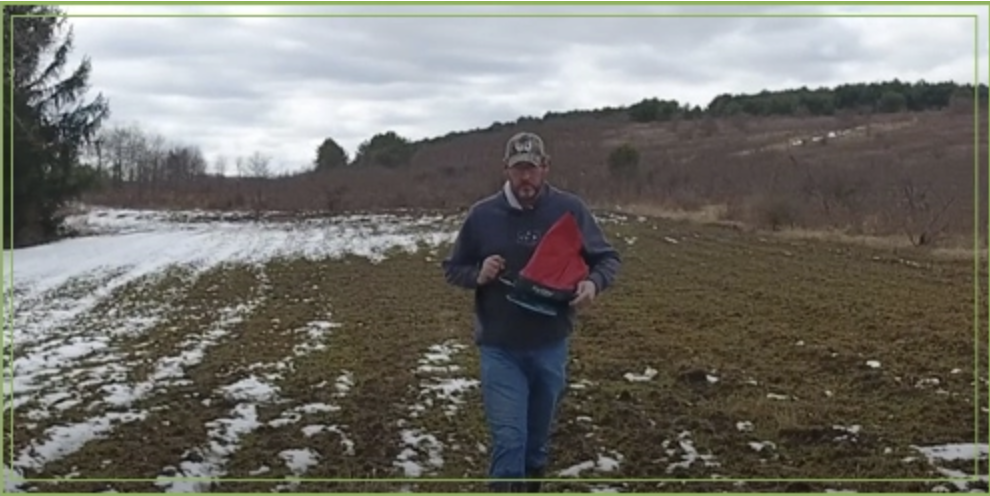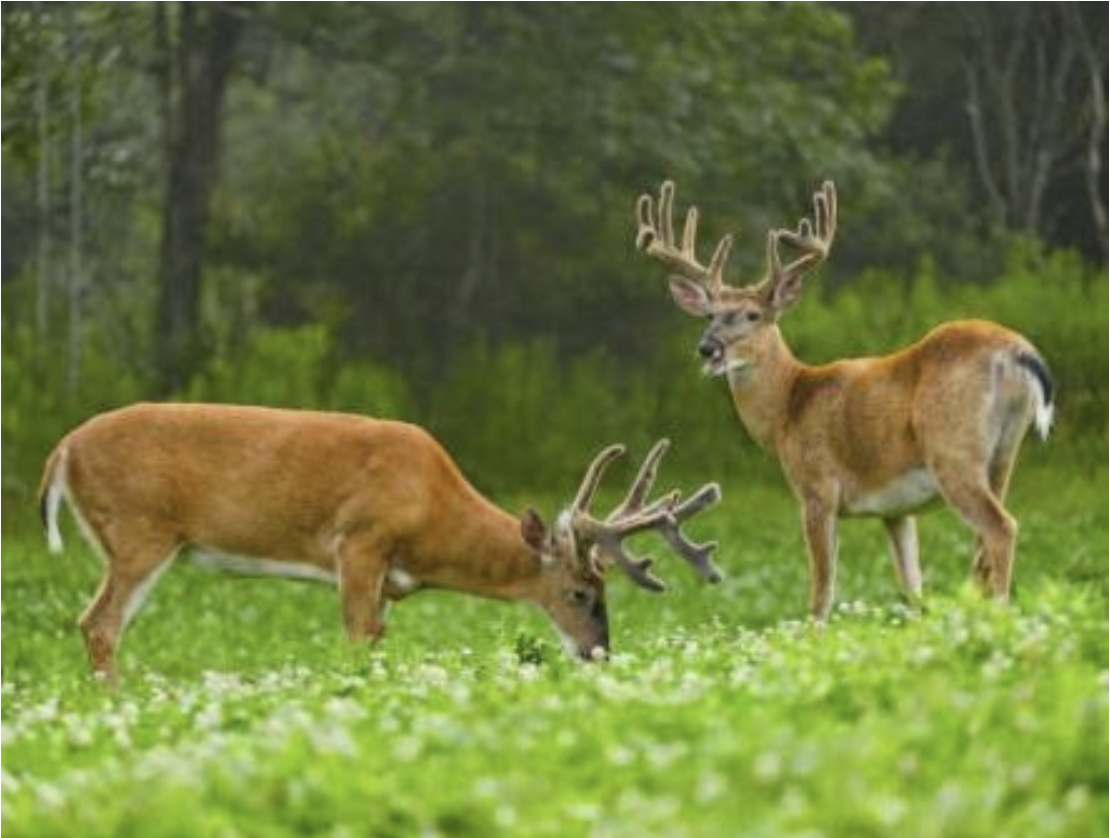Frost-Seeding is Simple, Effective, Economical!
 By Charles J. Alsheimer
By Charles J. Alsheimer
As a teenager growing up on a potato farm, I had a close friend whose family ran a dairy farm. Each spring, my friend’s father would frost-seed some of his clover fields. At the time, I thought this practice was strange because my dad and grandfather planted our potato and grain crops with a planter or drill in May or September, not when winter was fading into spring. So, I had a hard time believing anyone would attempt to plant a crop when there was still a skiff of snow on the ground. Little did I know at the time that one day I’d be doing the same kind of late winter planting.
When my wife and I purchased our farm in 1973, I immediately set out to offer the wildlife that called our place home a variety of food options. Initially I planted rye and winter wheat in early September. Whitetails loved both in fall, but as far as I could tell never touched these food plots once spring rolled around. In order to offer them food from spring through fall, I began putting in red clover food plots. At the time I knew of no seed company that had engineered a clover designed specifically for a whitetail’s needs, so I went with what local farmers used for their dairy cattle, which was red clover.
The biggest problem I encountered with my early red clover plantings was that I often had major plant die-offs after the first winter. That’s the big issue with red clover. Weeds soon took over the open gaps where the plants had died. In those early years, I knew little about frost-seeding, so to counter the clover plant’s die-off, I often replanted the plot if the die-off was substantial.
One day in the late 1980s I was invited to hunt woodchucks on the same dairy farm where I had watched my friend’s dad frost-seed during my youth. Afterward, my friend and I stopped at the barn to talk to his dad. During our discussion, the topic of food plots for deer came up, and I shared with the farmer the problem I was having with some of the clover dying off in my food plots. He asked me if I did any frost-seeding. When I said no, he shared that this was part of my problem and suggested I might want to give it a try. He went on to explain to me how he did it and how my food plots might benefit from the practice. Since that day, I’ve made it a point to frost- seed all of my Imperial Clover plots at the end of winter when spring is knocking on the door. I can’t praise the practice of frost-seeding enough because through the years, it has proven to be very successful and cost saving.
WHAT IS FROST-SEEDING?
I asked Dick Darling, a seed specialist for one of the largest agricultural companies in the Northeast, who advises farmers in the New York and the Northern Pennsylvania area (very similar winter to many provinces in Canada) on ways to increase crop yields about frost-seeding and he said this: “In the northern reaches of the United States and Canada, winter can be harsh on all things living, especially plants. If adequate snow is not present to cover the ground, plant die-off is a real possibility. When plant die-off takes place, food plots go from being a forage oasis to a blotchy-looking piece of ground when spring green-up rolls around. This results in less available forage and opens the door for weeds to take over. To counter this, farmers and food plot practitioners use the time-tested method of frost-seeding. By lightly broadcasting a perennial seed on the ground in late winter, certain crops like clover and chicory and alfalfa are able to maintain their lushness and provide high nutrition for multiple years.”
 WHEN DO YOU DO IT?
WHEN DO YOU DO IT?
Here in the North, some farmers frost-seed their clover fields as early as March 1. The down side of this is that in some cases there is still a fair amount of snow on the ground or more on its way. Frost seeding can be a problem when several inches of snow blanket uneven ground and a sudden thaw occurs and the seed washes away. What I have found works best is to wait until the snow is nearly gone. In my region of western New York State, this normally takes place the end of March.
“The key to frost-seeding is to do it when the ground is freezing and thawing on a daily basis,” said Darling. “This freezing and thawing action honeycombs the soil, causing the seed to fall into the cracks in the soil, which allows the seed to make direct contact with the soil.” Over the years, I’ve learned that my best results take place when I frost-seed early in the morning, when the ground is still frozen. Because you want to take advantage of the ground’s freezing/thawing action, broadcasting the seed should not be attempted if the ground is slick or partly thawed.
HOW TO DO IT?
One of the beauties of frost-seeding is that it requires very little equipment. I do all of my frost seeding with a strap-on shoulder hand-crank broadcaster. When the weather conditions tell me it’s time to frost-seed, I fill up my hand cranked seeder and begin walking the plot, applying a small amount of seed. I usually walk the plot in a clockwise manner to begin with, and then finish the broadcasting by walking the plot diagonally to make sure no spots are missed.
When it comes to seed application, “less is more.” In most cases broadcast between one third and half the amount of seed recommended for a new seeding. The goal is to fill in the missing plant gaps in the food plot.
WHICH SEEDS WORK BEST?
“Because the seed will lie on the snow or ground for an extended period of time only hard seeds should be considered for frost-seeding,” Darling said. “Often, people attempt to frost-seed forages like rye grass, orchard grass or brome grass, which are all soft seeds. Water soaks into soft seeds as they lay on the ground, causing them to rot before the ground warms enough for them to grow. So, any soft seed should be avoided for frost-seeding.”
Three of the best hard-seed blends for frost seed consideration are Imperial Clover, Imperial Fusion and Imperial Alfa- Rack. Imperial Whitetail is hard-coated, so neither will rot while on the ground waiting for spring and 10-degree Celsius ground temperatures to arrive before germinating. In addition, clover, chicory and alfalfa seeds are small, so they easily fall into the small crevasses created in the soil when the freezing and thawing action takes place. It is also important that the seed used for frost-seeding be inoculated. All Whitetail Institute products are inoculated and ready to plant.
BENEFITS
 There are many benefits that can be achieved with frost-seeding, and three of the most important are that it saves money, boosts the nutrition level of the food plot, and in some cases can control weeds.
There are many benefits that can be achieved with frost-seeding, and three of the most important are that it saves money, boosts the nutrition level of the food plot, and in some cases can control weeds.
Cost savings: By frost-seeding an existing perennial food plot, the plot’s annual cost can drop by 70 percent to 75 percent after the first year. Typically, with proper weed control (spraying and mowing), frost-seeding and annual fertilizing, I’m able to get five years out of most of my Imperial Clover food plots
Though frost-seeding can be a real bargain, each perennial food plot should be evaluated on a yearly basis to make sure frost-seeding is the way to go. Two questions you should try to answer before considering frost-seeding are:
1) Is the current food plot nearing the end of its lifespan?
2) How bad is the food plot’s weed infestation?
Being able to address these questions will determine if it’s time to replant or frost-seed.
Nutrition: A second benefit of frost-seeding is that it allows the food plot to have even more young plants in the food plot. Because the nutritional level of younger plants is greater than that of mature plants, the food plot’s overall nutritional level stays as high as possible throughout the food plot’s life.
Weed control: Frost-seeding with Imperial Clover, Imperial Fusion or Imperial Alfa-Rack before spring green-up can help with grass and weed control. This is because clover tends to germinate and begin growing in cooler ground temperatures than many native grasses and weed seeds. Generally, when the ground temperature reaches 10 degrees Celsius, clover, chicory and alfalfa seeds begin growing.
